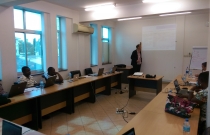Network Modeling and Load Flow Analyses
17.06.2016
With the goal of building transmission system planning expertise, a five-day workshop on load flow modelling and analysis in the Power System Simulator for Engineers (PSS/E) network planning software was conducted on June 13-17, 2016 in Dar es Salaam, Tanzania for the Tanzania Electric Supply Company, Ltd. (TANESCO).
The training was conducted through a series of theoretical PowerPoint presentations delivered by one trainer while the other trainers were available to the participants for assistance. The presentations were followed by a series of interactive PSS/E exercises.
Day 1
- Introduction to PSS/E software working environment
- Program overview
- Graphical interface
- Program options and settings
- Working with files
- Building new model
- Hands-on exercise
- Network modelling
- Basic modelling principles in EATP regional model (bus names, numbers, areas, voltage levels, etc.)
- Buses
- Loads
- Branches
- Hands-on exercise
Day 2
- Network modelling
- Machines
- Transformers
- Shunts
- Breakers
- Hands-on exercise
- Graphical Representation
- Create single line diagram
- Changing data using diagram
- Diagram properties
- Hands-on exercise
- Modifying network data
- Renumbering
- Deleting/Join/Moving
- Scaling
- Hands-on exercise
Day 3
- Power flow simulations
- Data checking
- Parameter settings
- Running LF simulations
- Reports
- Network limit violations
- Hands-on exercise
- Contingency analyses
- Preparation of sub-system, monitoring, contingency and distribution-factor data files for running the automatic contingency analysis
- Configuration file builder
- Running automatic contingency analysis
- Interpreting reports of contingency analysis
- Hands-on exercise
- Creation of network models for TANESCO
- Overview of current TANESCO models
- Modelling quality
- Handling the raw data in PSS/E (copy from excel sheets etc.)
- Harmonization requirements (power balances, codification etc.)
- Model validation
- Main principles
- Model validation algorithm
- Data requirements
- Introduction to short circuit modelling
- Input data
- Training program for short circuit analyses

